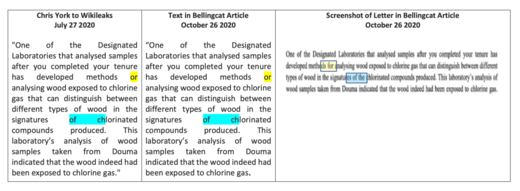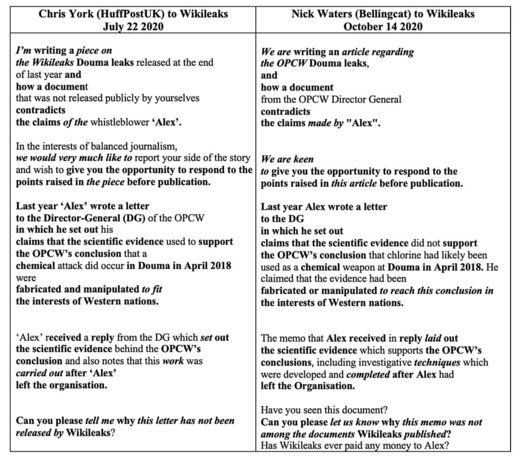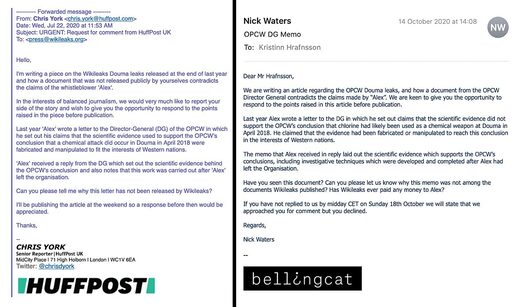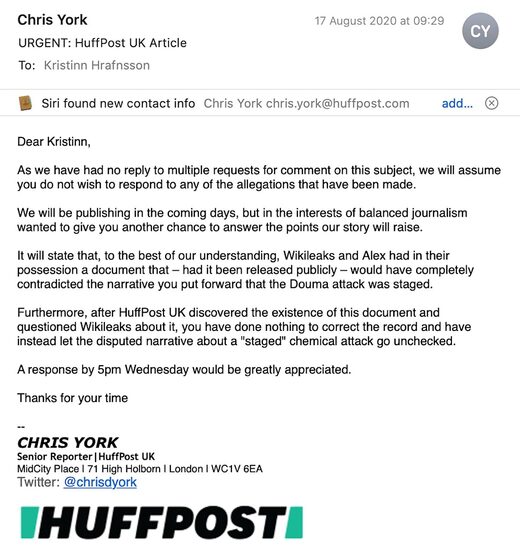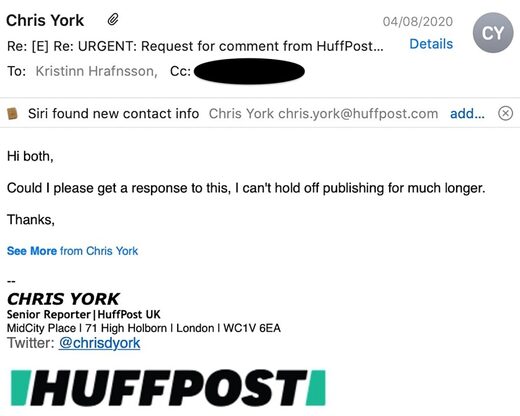By Aaron MATÉ
After publishing fraudulent claims in a bid to smear OPCW whistleblowers, Bellingcat has been caught in another subterfuge that contradicts its stated allegiance to “transparency and accountability”: a hidden, external author writing its material.
The website Bellingcat promotes itself as a collective of digital sleuths who “pledge allegiance to truth and evidence and abide by the principles of transparency and accountability.” Its self-described “groundbreaking investigations,” especially those aimed at Russia and Syria, have led to fawning Western media endorsements of its claim to be an “intelligence agency for the people.”
But Bellingcat’s carefully crafted public image as an “open source” outlet is belied by its extensive NATO government ties and a conspicuous pattern of conduct in line with its state sponsors’ interests. Bellingcat has hauled in grants from the National Endowment for Democracy, a US government-funded CIA cutout. Leaked documents reported by The Grayzone revealed that Bellingcat has collaborated with a UK Foreign Office operation that aims to “weaken Russia.”
Bellingcat has also been a regular source of interventionist material on Syria, the target of a decade-long, multi-billion dollar proxy war waged by the US, UK, and their allies. This includes participating in a nearly two-year campaign to whitewash a scandal at the Organisation for the Prohibition of Chemical Weapons (OPCW) — one of the most shocking and well-documented pro-war deceptions since the lead-up to the 2003 invasion of Iraq.
A series of leaks has exposed how top OPCW officials censored findings which undermined US-led allegations of a Syrian government chemical weapons attack in the city of Douma in April 2018. Together with its NATO state sponsors, Bellingcat has worked to bury the cover-up and denigrate two OPCW whistleblowers who challenged it from the inside.
Bellingcat’s disinformation efforts resulted in an embarrassing debacle late last year, when the outlet was caught publishing fraudulent material about one of the dissenting OPCW scientists.
Now, emails obtained by The Grayzone reveal that Bellingcat has engaged in more subterfuge than was previously known.
Messages sent months before the “Bellingcat Investigation Team” released its bogus article show that Bellingcat was not the sole author of the now-discredited piece published in its name. It also was not the first one.
The communications show that someone outside the Bellingcat organization composed portions of the fraudulent material that ultimately appeared on Bellingcat’s website. An external author even drafted questions that Bellingcat sent to multiple recipients. Bellingcat’s duplicitous conduct took place in the midst of a poorly coordinated effort involving HuffPost UK and the BBC – two outlets that also enjoy close ties to the British state.
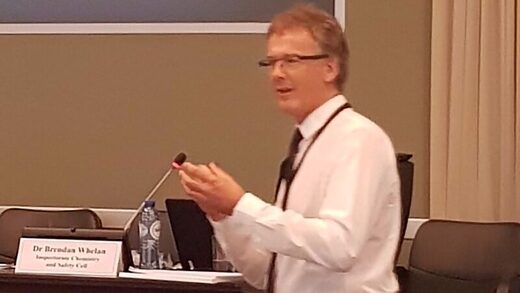
The target of the Bellingcat-led smear campaign is Dr. Brendan Whelan, a 16-year OPCW veteran and member of the mission that deployed to Syria in April 2018 to investigate the alleged chemical attack in Douma.
The Douma team failed to find any evidence of chemical weapons use, shattering the pretext for the US, UK, and French airstrikes on Damascus that same month. But the investigators’ original report was doctored and suppressed, an act of censorship that Whelan protested in an email which was subsequently leaked along with other damning internal OPCW documents.
The leaks also revealed how the Douma inspectors were sidelined from the probe following Whelan’s protest, leading to a final report that excluded their critical findings. That report, released in March 2019, reached the unsupported conclusion that there were “reasonable grounds” to believe that chlorine gas was used in Douma, aligning with the US-led narrative of Syrian government culpability.
Last October, over a year after the cover-up became public, Bellingcat claimed to have obtained a “draft version” of an OPCW letter sent to Whelan that disproved all of his concerns. The Grayzone quickly demonstrated that Bellingcat’s “letter” was a sham.
When The Grayzone obtained the real OPCW letter sent to Whelan, it contained none of Bellingcat’s distorted text. The Bellingcat letter claimed that new scientific “methods” had found “chlorinated pinene compounds” in Douma wood samples that proved chlorine gas use. It also stated that Russia and Syria had secretly accepted the OPCW’s conclusions. However, the OPCW’s own published documents undermined both assertions.
Bellingcat has refused to explain the fraud that it perpetrated. Nick Waters, a Bellingcat staffer who was directly involved in producing the anonymously bylined story, deleted embarrassing tweets in which he gloated about his fake scoop. Since then, Waters has ignored queries from The Grayzone.
Now that @Bellingcat has admitted that it published disinformation (https://t.co/B7WiqyvBJZ), let’s look at those who tried to accuse others of doing what Bellingcat in fact did themselves, and even gloated that the falsely premised article was some kind of vindication.
— Aaron Maté (@aaronjmate) October 29, 2020
Bellingcat has now been caught in another act of deception.
Identical typos reveal Bellingcat’s hidden author
Emails obtained by The Grayzone show that at least eight months before Bellingcat published its fraudulent article impugning the OPCW whistleblower, a staffer for HuffPost UK pursued the same story. He is Chris York, a writer responsible for a consistent stream of attacks on prominent critics of the official story of Syrian government responsibility for a chemical attack in Douma – an odd niche for a reporter who scarcely mentioned Syria before 2017.
Chris York writes for the Huffington Post UK. © Chris York/Twitter
In one such email, York claimed to be on the verge of publication. Then, for some reason, he pulled back.
Bellingcat not only published the story that York claimed he was about to release, but used text that was identical to his in their final product.
In its October 2020 article, Bellingcat quoted the letter that it claimed the OPCW had leaked. A side-by-side comparison of Bellingcat’s transcription of the letter in its article to the screenshot of the letter that it also published reveals two errors: a typographical error, and an omission of one definite article that appears in the original screenshot.
These errors were not made by Bellingcat. Instead, three months earlier, on July 27, Chris York of HuffPostUK sent an email to Wikileaks containing the same two errors in otherwise identical text. This can be seen by comparing York and Bellingcat’s text to Bellingcat’s screenshot:
- Bellingcat’s screenshot says “developed methods for analysing wood”; by comparison, Bellingcat’s article, like York’s email, says “developed methods or analysing wood.”
- Bellingcat’s screenshot says “different types of wood in the signatures of the chlorinated compounds produced”; by comparison, Bellingcat’s article, like York’s email, says “different types of wood in the signatures of chlorinated compounds produced.”
HuffPost UK Chris York Bellingcat OPCW email

Left: Chris York’s July 27 2020 email to Wikileaks erroneously quotes the purported OPCW document. York’s typos are highlighted.
Right: Bellingcat’s October 26 2020 article repeats Chris York’s typos, instead of accurately quoting the screenshot that it published in its article. (The screenshot is in the first table above, as well as here: https://archive.is/1O3Du)
The typos are beyond any possible coincidence, and not the only overlap. Nick Waters of Bellingcat not only published Chris York’s errors, but also copied questions that York had sent months earlier.
Bellingcat “investigator” asks someone else’s questions
In emailing queries to Wikileaks, Whelan, and me, Bellingcat’s Nick Waters once again used text originally sent by Chris York of HuffPost UK. A comparison shows that Waters’ queries in October are near carbon copies of queries that York sent in July.
York’s and Waters’ questions to Wikileaks contain virtually identical structure and verbiage across multiple paragraphs. (Waters also used the same language in emails that he sent to me and to Whelan).
Bellingcat Huffpost UK Chris York emails OPCW
Given that Bellingcat copied someone else’s text and did not write its own questions, the question that now arises is how and where Bellingcat’s material originated.
One option is that Waters received York’s material and copied his entire set of questions, slightly changing the wording in a lazy effort to disguise the copying job. That would raise the question of how Bellingcat ended up with another outlet’s question: did York pass his questions to Waters? Or did someone else?
Another option is that neither Waters nor York wrote their overlapping questions or text to begin with, and received them instead from a mutual source.
What is indisputable is that Bellingcat’s Nick Waters did not write the questions that he presented as his own.
The Grayzone sent multiple queries to Waters and Bellingcat about the overlap between their material and HuffPost UK’s. They have not responded.
“I can’t hold off publishing much longer”: How did Bellingcat get HuffPost UK’s leftovers?
The fact that Bellingcat had its text circulated by another outlet months before raises serious questions about what role Bellingcat played in its “investigation.”
The chain of events began in early 2020, when Chris York of HuffPost UK first referenced the “document” that Bellingcat would later base its story on.
York wrote Dr. Brendan Whelan in February 2020, shortly after the OPCW released an internal inquiry baselessly maligning two whistleblowers it identified as Inspectors A and B. Just days before the inquiry’s findings were announced, the British journalist Brian Whittaker doxed Whelan, whose name he said had been leaked by someone with “access to sensitive OPCW information.” That same month, Bellingcat published an attack piece that identified Whelan as Inspector B.
In light of those attacks, the timing and nature of York’s outreach to Whelan suggests that it may have been a part of a coordinated effort to impugn him.
“I was hoping to speak to you about some documents that Wikileaks do not appear to have released yet,” York wrote to Whelan on February 26, 2020. Whelan did not reply. York followed up again on March 7th, which Whelan also ignored.
Four months later, York sent Whelan a final message claiming that publication was imminent. “I’ll soon be publishing an article on the Wikileaks Douma leaks, specifically on a document that wasn’t publicly released but appears to contradict some of the points Wikileaks and yourself have put forward,” York wrote on July 16.
During this same period, York also reached out to Wikileaks editor-in-chief Kristinn Hrafnsson. In one email, York shared with Hrafnsson the same error-laden transcription of part of the text of the OPCW draft letter that would later surface at Bellingcat. Just as Bellingcat would do months later, York additionally accused Wikileaks of hiding the document. Releasing it, York alleged on August 17, “would have completely contradicted the narrative you put forward that the Douma attack was staged.”
York was so confident in his false belief that the document disproved the whistleblower – and that others beyond him had actually received it – that he chided Wikileaks for failing to issue a public correction in response. “[A]fter HuffPost UK discovered the existence of this document and questioned Wikileaks about it,” York scolded, “you have done nothing to correct the record and have instead let the disputed narrative about a ‘staged’ chemical attack go unchecked.”
The fact that York claimed to have “discovered” the document suggests that it was only passed to Bellingcat after HuffPost UK dropped the story. Bellingcat’s omission of HuffPost UK’s original role – while simultaneously copying the fraudulent content of its text – demonstrates a flagrant disregard for transparency that stands at odds with Bellingcat’s professed fidelity to “open source,” “verifiable” evidence.
Just as he did with Whelan, York informed Wikileaks that he was on the verge of publishing his story. “I’ll be publishing the article at the weekend so a response before then would be appreciated,” York wrote Hrafnsson on July 22. On August 4th, York followed-up with one final plea: “Could I please get a response to this, I can’t hold off publishing much longer.”
York’s article never appeared at the HuffPost UK.
In a brief phone conservation with me on October 27th, the day after his story surfaced at Bellingcat, York said that he would read the Bellingcat article before responding to my questions. He has since gone quiet and failed to respond to multiple emailed queries from The Grayzone. His editors at HuffPost UK have kept mum as well.
Converging disinformation from Bellingcat and BBC
Although the identity Bellingcat-HuffPost UK’s dodgy source is unknown, the participation of a third outlet in this story – the UK state broadcaster BBC — offers a strong candidate.
Just weeks after Bellingcat’s debunked story appeared, the BBC released a podcast that attempted to advance the same bogus line. Mayday host Chloe Hadjimatheou repeated the Bellingcat letter’s falsehoods about the wood samples and the secret Syria-Russian acceptance of the OPCW’s final report. In yet another uncanny crossover, Hadjimatheou also falsely suggested that one of the OPCW whistleblowers received a payment from Wikileaks. In emails to Wikileaks and Whelan one month before Mayday was aired, Bellingcat’s Nick Waters made the same insinuation.
While her uncritical promotion of the Bellingcat-HuffPost UK letter’s debunked assertions was nothing new, Hadjimatheou did offer one significant contribution. To make her case against the whistleblowers, Hadjimatheou interviewed someone whom she claimed was an anonymous OPCW official operating behind the pseudonym, “Leon.” Hadjimatheou did not specify what role, if any, Leon played in the Douma investigation. The anonymous official also offered nothing of substance beyond what was already claimed in the bogus OPCW letter released by Bellingcat.
It is possible, therefore, that Leon was the real source of the fraudulent information provided to Bellingcat and HuffPost UK. If the BBC is correct that Leon is an actual OPCW official, then the implications are serious. It means that alongside the OPCW’s refusal to account for the Douma cover-up, an OPCW staffer is spreading disinformation about former employees who challenged it.
The OPCW did not respond to The Grayzone’s questions about whether it is investigating the “draft letter,” or Leon’s comments to the BBC. If the OPCW is not probing this defamatory conduct, its inaction could be read as a tacit endorsement.
The Grayzone also asked the BBC’s Hadjimatheou about her recycling of Bellingcat’s debunked claims, Leon’s qualifications to comment on the Douma investigation, and other major lapses in her reporting. Hadjimatheou initially said that she would reply to me in writing. After receiving my questions, she backtracked on that pledge and declined to offer any responses.
In the absence of any explanation from these three outlets – BBC, Bellingcat, and HuffPost UK – on how they have targeted OPCW whistleblowers with identical false material repeated by an unidentified OPCW source, another common denominator might help fill in the silence. Just like the BBC, Bellingcat and HuffPost UK have formal British government ties of their own.
The editor of HuffPost UK, Jess Brammar, has helmed the outlet while simultaneously serving as a member of the UK government’s Defence and Security Media Advisory (DSMA) Committee, which censors journalism on behalf of “UK military and intelligence operations,” in the name of “national security.”
For its part, Bellingcat is a founding “partner” in a UK government propaganda operation, the Open Information Partnership (OIP), funded with $13.7 million in taxpayer money. Bellingcat was enlisted in the OIP even though its UK state partners have privately doubted its credibility. A leaked internal assessment produced for the OIP concluded that:
“Bellingcat was somewhat discredited, both by spreading disinformation itself, and by being willing to produce reports for anyone willing to pay.”
Whoever is behind the attacks on veteran OPCW scientists, Bellingcat’s role in the smear campaign is absolutely clear. While marketing itself publicly as an “open source” collective of crime-solving digital sleuths, Bellingcat has been used as a proxy in a disinformation campaign to whitewash a major global deception and defame the whistleblowers who challenged it. It is duplicitous enough to let someone else write its material, and sloppy enough to get caught.






